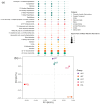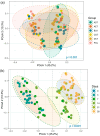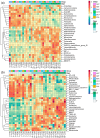Different Emergency Response Strategies to Oil Spills in Rivers Lead to Divergent Contamination Compositions and Microbial Community Response Characteristics
- PMID: 40572080
- PMCID: PMC12195274
- DOI: 10.3390/microorganisms13061193
Different Emergency Response Strategies to Oil Spills in Rivers Lead to Divergent Contamination Compositions and Microbial Community Response Characteristics
Abstract
Oil spills in inland rivers pose a significant threat to the surrounding environment, and the emergency response differs greatly from that in ocean or coastal areas. In this study, we focused on several commonly used emergency water treatment strategies in China's inland oil spills, as well as the spilled washing oil in a serious accident case. We investigated the changes in oil-related chemical components before and after water treatment using GCxGC-TOF MS (Comprehensive Two-dimensional Gas Chromatography Time of Flight Mass Spectrometer). We tracked the shifts of microbial communities in the microcosms incubated with clean river water, simulated oil-contaminated water, and the treatment effluent. The results revealed that typical components, especially nitrogen-containing heterocyclic compounds, had different removal efficiencies among treatments. The diversity, composition, and potential functions of microbial communities responded differently to the treatments, and could be related to various substances, including PAHs (polycyclic aromatic hydrocarbons) and heterocyclic compounds. A few genera, such as SC-I-84, exhibited a high correlation with washing oil-related components and could serve as an indicator in such an oil spill emergency response. Our findings indicated that simply using petroleum oil or PAHs to evaluate oil spills was likely to underestimate the ecological impact, especially when the spilled substances were coal chemical products widely used in China. This will provide an important scientific basis for decision-making and strategy evaluation in emergency responses to inland oil spills.
Keywords: emergency response; microbial community; oil spill; river sediment; washing oil.
Conflict of interest statement
The authors declare no conflicts of interest.
Figures






References
-
- Idomeh J., Shittu O., Oyedepo J., Bada B., Balogun S., Idomeh F., Ezenweani R. Petroleum Hydrocarbon Impacted Aquatic Ecosystem Reveals Methylotenera as the Dominant Genera in the Niger Delta Region of Nigeria. Geomicrobiol. J. 2021;38:879–894. doi: 10.1080/01490451.2021.1973614. - DOI
-
- Rezaei Somee M., Dastgheib S.M.M., Shavandi M., Ghanbari Maman L., Kavousi K., Amoozegar M.A., Mehrshad M. Distinct microbial community along the chronic oil pollution continuum of the Persian Gulf converge with oil spill accidents. Sci. Rep. 2021;11:11316. doi: 10.1038/s41598-021-90735-0. - DOI - PMC - PubMed
-
- Huettel M. Oil pollution of beaches. Curr. Opin. Chem. Eng. 2022;36:100803. doi: 10.1016/j.coche.2022.100803. - DOI
-
- Lu J., Chen L., Xu D. Study on the Oil Spill Transport Behavior and Multifactorial Effects of the Lancang River Crossing Pipeline. Appl. Sci. 2024;14:3455. doi: 10.3390/app14083455. - DOI
-
- Yang Y., Wang S., Zhu Z., Jin L. Prediction model and consequence analysis for riverine oil spills. Front. Environ. Sci. 2022;10:1054839. doi: 10.3389/fenvs.2022.1054839. - DOI
Grants and funding
LinkOut - more resources
Full Text Sources

